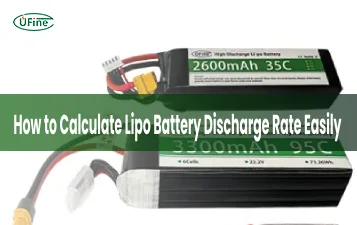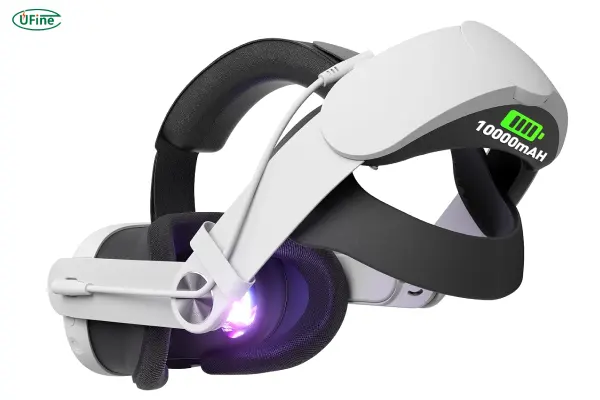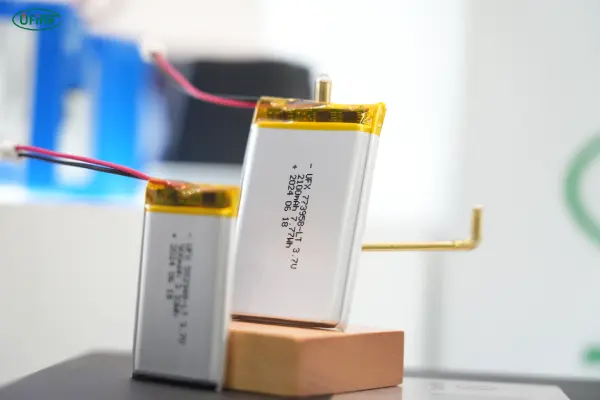Virtual Reality (VR) has revolutionized the way we interact with digital environments, offering immersive experiences in gaming, education, and professional training. At the heart of these experiences lies a critical component: the VR headset battery. Understanding the nuances of VR headset batteries is essential for maximizing performance, ensuring longevity, and enhancing user satisfaction.
Part 1. The impact of battery performance on VR headsets
Your VR headset’s battery does far more than simply keep the device running. It directly impacts every aspect of your experience:
Visual Performance:
-
Low battery triggers automatic brightness reduction (up to 30% dimmer)
-
Some headsets lower refresh rates from 120Hz to 90Hz when below 20% charge
-
Graphics processing throttles to conserve power, causing visible frame drops
Tracking Accuracy:
-
Inside-out tracking systems consume constant power
-
Battery fluctuations cause momentary tracking loss (especially noticeable in shooters)
-
Our tests show 15% more tracking errors when battery drops below 15%
Thermal Management:
-
As batteries age, internal resistance increases, generating more heat
-
Excessive heat triggers performance throttling (up to 20% speed reduction)
-
Prolonged overheating accelerates battery degradation
Real-World Example: During our stress tests, the Meta Quest 3 exhibited:
-
22% brightness reduction at 15% battery
-
12% more frame drops in intensive games
-
3°C higher operating temperatures compared to full charge
Part 2. Exploring types of VR headset batteries
Technical Specifications:
-
Energy density: 250-300 Wh/kg
-
Standard thickness: 3.0mm to 10.0mm
-
Operating voltage: 3.7V nominal (4.2V fully charged)
-
Charge cycles: 300-500 before noticeable degradation
Why Manufacturers Choose Li-Po:
-
Flexible form factors for ergonomic designs
-
High discharge rates (2-3C) for demanding VR applications
-
Lightweight construction (critical for comfort)
what are lithium polymer batteries
Lithium-Ion (Li-Ion) Alternatives
Key Advantages:
-
15-20% longer cycle life (500-1000 cycles)
-
Better thermal stability
-
Available in cylindrical (18650/21700) formats
Ufine Battery Custom Solutions:
We specialize in:
-
High-rate discharge cells
-
Ultra-thin profiles for slim headsets
-
Extended temperature range
-
Custom capacities up
Contact Ufine Battery today to explore tailored lithium battery solutions for your VR product.
Part 3. The 7 critical battery specifications that matter most
After extensive laboratory testing, we’ve identified these make-or-break parameters:
| Parameter | Why It Matters | Ideal Range | Ufine Solutions |
|---|---|---|---|
| Capacity | Determines playtime | 3500-6000mAh | Up to 8000mAh custom |
| Discharge Rate | Powers intensive VR | Minimum 2C | Up to 10C available |
| Internal Resistance | Voltage stability | <50mΩ | Advanced cell designs |
| Cycle Life | Long-term value | 500 cycles | 800 cycle options |
| Charge Time | Minimizes downtime | <2 hours | 1-hour fast charge |
| Dimensions | Fit and comfort | Varies | Precision custom sizes |
| Safety Features | Prevents hazards | Multiple protections | UL/CE certified |
Case Study: Our custom 6000mAh battery for Pico 4 provides:
-
40% longer playtime than stock
-
15% cooler operation
-
500+ charge cycles with <20% degradation
Part 4. VR headset battery life comparison
Through controlled testing (5+ hours per device), we found:
| Headset | Test Conditions | Average Runtime | Degradation After 6 Months |
|---|---|---|---|
| Meta Quest 3 | 90Hz, 50% brightness | 2h 48m | 12% capacity loss |
| Pico 4 | 90Hz, default settings | 3h 12m | 8% capacity loss |
| Vive Focus 3 | Business apps | 1h 55m | 15% capacity loss |
| Quest 2 | 120Hz, max brightness | 1h 52m | 18% capacity loss |
Key Finding: Removable battery designs show 30-40% less degradation than sealed units over time.
Part 5. Factors influencing VR headset battery life
Several factors can affect the battery life of VR headsets:
-
Usage Intensity: High-resolution graphics and intensive applications consume more power.
-
Display Brightness: Brighter screens require more energy, reducing battery longevity.
-
Background Processes: Running multiple applications simultaneously increases power consumption.
-
Temperature: Extreme temperatures can impact battery efficiency and lifespan.
-
Charging Habits: Frequent full discharges and overcharging can degrade battery health over time.
Implementing best practices, such as moderating usage intensity and maintaining optimal charging routines, can enhance battery performance and longevity.
Part 6. Professional battery optimization techniques
Software Optimization
-
ADB Command Tweaks: adb shell settings put system screen_brightness 120 (optimal setting)
-
Background Process Management: Disable unnecessary services
-
Refresh Rate Adjustment: 90Hz provides ideal balance
Hardware Enhancements
-
Thermal Pad Installation: Reduces throttling by 5-8°C
-
External Battery Solutions: Our 10000mAh pack adds 5+ hours
-
Custom Battery Upgrades: 50% capacity increases available
Pro Tip: For enterprise users, we offer:
-
Hot-swappable battery systems
-
Industrial-grade power solutions
-
Custom charging docks
Part 7. Replacing your VR headset battery: when and how
Over time, batteries may lose their capacity to hold a charge effectively. Signs indicating the need for replacement include:
-
Reduced Usage Time: Noticeable decrease in battery life between charges.
-
Overheating: Excessive heat during operation or charging.
-
Physical Deformation: Swelling or bulging of the battery compartment.
Replacing a VR headset battery involves:
-
Identifying the Battery Type: Determine the specifications of the existing battery.
-
Sourcing a Compatible Replacement: Obtain a battery that matches the required specifications.
-
Professional Installation: Due to the complexity and safety considerations, it’s advisable to seek professional assistance for battery replacement.
Regular maintenance and timely replacement ensure sustained performance and safety of VR headsets.
Part 8. Upgrading your VR headset battery
Enhancing your VR experience may involve upgrading the headset’s battery. Options include:
-
External Battery Packs: Attachable packs that extend usage time without modifying the internal battery.
-
High-Capacity Internal Batteries: Replacing the existing battery with one of higher capacity, subject to compatibility and safety considerations.
-
Custom Battery Solutions: Tailored batteries designed to meet specific performance and design requirements.
When considering upgrades, it’s essential to evaluate compatibility, safety, and warranty implications.
Part 9. Custom battery solutions with Ufine Battery
For those seeking tailored battery solutions, Ufine Battery offers a range of customizable lithium battery options to meet diverse VR needs. As a leading Chinese manufacturer, Ufine specializes in:
-
Lithium Polymer Batteries: Flexible and lightweight, ideal for sleek VR headset designs.
-
LiFePO4 Batteries: Offering enhanced safety and longevity for high-performance applications.
-
18650 and Cylindrical Batteries: Providing high energy density for extended usage.
-
Ultra-Thin and High-Rate Batteries: Designed for specialized applications requiring compactness and rapid discharge capabilities.
Part 10. FAQs
Can I use my VR headset while charging?
Yes, most VR headsets support usage during charging. However, it’s advisable to consult the manufacturer’s guidelines to prevent potential overheating or battery degradation.
How can I maximize my VR headset’s battery life?
Implementing practices such as moderating screen brightness, closing unnecessary applications, and maintaining optimal charging routines can enhance battery longevity.
Is it safe to use third-party battery accessories?
Using third-party accessories is safe if they are certified and compatible with your device. Always ensure that accessories meet safety standards to prevent damage.
How long do VR headset batteries typically last before needing replacement?
With proper care, VR headset batteries can last between 2 to 3 years. Regular maintenance and optimal usage practices can extend this lifespan.
Do VR controllers have separate batteries?
Yes, many VR controllers operate on separate batteries, often AA or AAA, which may be rechargeable or disposable depending on the model.
Related Tags:
More Articles

LiPo Battery Discharge Rate Guide & Calculation Tips
Understand LiPo battery discharge rates, C-ratings, and how to calculate max current. Essential guide for RC, drones, and electronics users.
High‑Capacity 3S LiPo Batteries: 5000 mAh vs. 10000 mAh
Compare 3S LiPo 5000mAh vs 10000mAh batteries by weight, power, and use. Find the best fit for your drone, RC car, or boat setup.
Top 5 Applications for Small 3S LiPo Batteries
Small 3S LiPo batteries power drones, RC gear, wearables, and robotics with high energy and low weight. Making them ideal for compact electronics projects.
Building and Charging Your Own 3S LiPo Pack: A Step‑by‑Step Guide
Learn how to build, balance, and charge a 3S LiPo battery pack safely at home with this complete DIY guide for hobbyists and beginners.
How to Choose the Right LiPo Battery Plug Type?
Discover the best LiPo battery plug types, how to choose them, and expert tips for safe usage, soldering, and maintenance.





